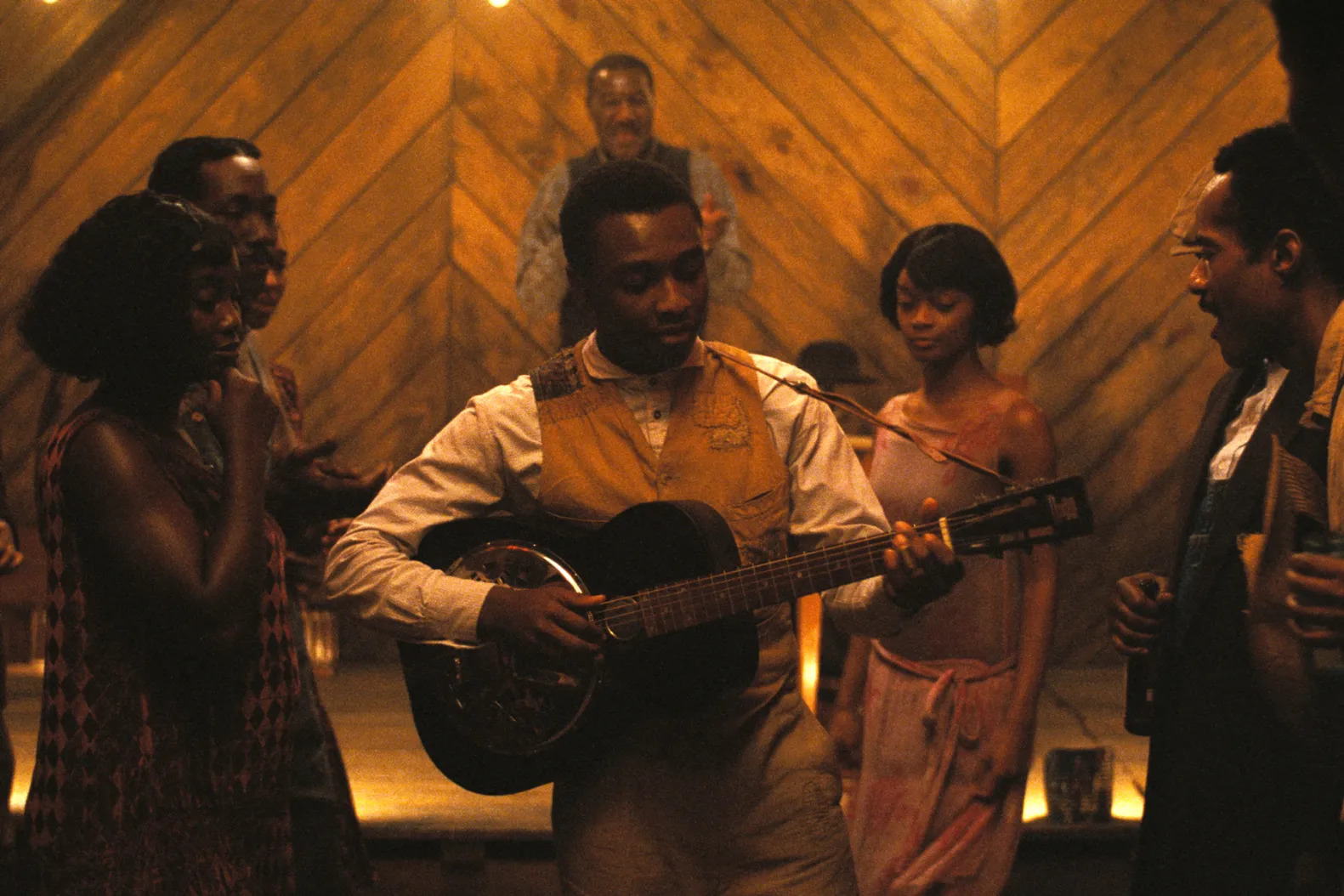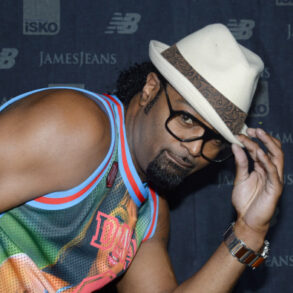
Writer-director Ryan Coogler’s Sinners – an R-rated, original horror-action-period-piece in a field of films based on time-tested brands – is the year’s second highest-grossing movie in the U.S., just behind one of those kid-friendly IP goldmines. The first must-see film of the summer is finally coming to digital services on June 3. Sinners has reportedly made Coogler one of the fifty highest-grossing directors ever, following his turns helming Marvel’s Black Panther franchise, the Creed trilogy from the Rocky cinematic universe, and his first feature film, Fruitvale Station, a portrait of the life of police brutality victim Oscar Grant that Coogler also wrote himself.
Coogler drew from vampire lore and a beloved great uncle’s passion for delta blues music to draw the lines between the Black American experience, past, present, and future in Sinners, set on one sweltering 1932 day in Clarksdale, Mississippi. Though he revered the love his late, great uncle James Edmonson had for acts like Albert King and Buddy Guy, the blues required great study for Coogler, whose life had been defined by rap. Much like hip-hop more broadly, in Sinners, the blues are the soundtrack of defiance, pain, joy, and solidarity for a swath of Black folks subjected to the real horrors of abject racism. “It’s a story of echoes and those echoes colliding,” Coogler says of his film.
“Blues is the entry point to the movie for me, but if blues was the entry point, hip-hop was the car that I was driving in,” Coogler tells Rolling Stone as he settles into a Zoom call from his home office in Oakland. He was born there in 1986, as local legend MC Hammer went on to make waves, gangsta rap sparked national intrigue and dismay, and Oakland adoptee Tupac was on his way to becoming one of the most influential artists of all time. “For every music that I come across in my life experience, hip-hop is what I know as being mine. It’s my native language. And so for me to really feel like I could make this movie, I had to truly understand that blues was hip-hop’s ancestor.”
Coogler says he came to see blues as the gangsta rap of its era, replete with stories of death and survival. The cutthroat hustle of the archetypical gangsta rapper courses through Sinners’ protagonists, twins Smoke and Stack, both played by Michael B. Jordan. Though they’re not musicians themselves, they survived World War I and finessed Al Capone in gangland Chicago before returning to Clarksdale to open a juke joint where the local sharecropping community could enjoy live blues. Money, though, is the twins’ motive, as they readily haggle with, intimidate, and even harm anyone who stands in their way.
In the film, Coogler most clearly articulates the throughlines between the blues, hip-hop, and the African music that came before both in a supernatural dance montage at the juke joint, choreographed by Aakomon Jones, who joins us on the Zoom call. “A lot of us know blues because of hip-hop,” Jones says. “We know funk, jazz, rock & roll, and then you get to the origin of all of those things, it all stems from an African diaspora.”
In the montage, another protagonist, Sammie “Preacher Boy” Moore, played by newcomer Miles Caton, is able to conjure the ancestors and progeny of everyone in the room with his stunning musicianship as an inheritor of the West African griot tradition. As he takes his guitar and sings “I Lied to You” of disobeying his pastor father to play the blues, he’s mystically accompanied by an older African man, strumming a lute. A cowry-shelled dancer, elaborate masquerades, and drummers emerge. A spacey, Parliament-Funkadelic-esque electric guitarist appears next to him. In one sweeping shot, the dance floor of blues people fills with Black folks from the future: b-boys, women twerking in tennis skirts, and West Coast gangsters bopping along. G-funk synths and trap bass blend with Sammie’s song. “With this here ritual,” narrates Delta Slim, an elder bluesman who mentors Sammie, “We heal our people, and we be free.”
“For me, that scene is my life,” says Coogler, who holds his iPhone to his computer camera to show us footage from his wife Zinzi’s recent birthday party. Zinzi Coogler, one of Sinners’ producers, turned 40 years old the day before the movie premiered in April, and they celebrated with a sunny, outdoor bash. He pulls up a photo of himself and a pregnant Zinzi hitting the Casper slide stylishly, low to the ground, with his mom and her sister behind them. In another, he dances behind his 96-year-old grandmother, grinning from her wheelchair, holding hands with more family. In another, his uncle James’ daughter holds a baby cousin in her arms. He scrolls to photos of his young son holding a camera (Coogler says the boy decided to snap photos on his own) and his daughter embracing her brother. “There was a time in the ’90s when that was us every weekend, what happened at the Juke joint,” Coogler says.
“This country made it its business to split my ancestors up, whenever it was financially beneficial for certain individuals,” he says on the importance of tracing these echoes. “I got a family who was very intergenerational since slavery was abolished. They fled the Jim Crow South. We make it our business to stick around each other. I could not justify [making] a movie with vampires biting into people’s necks without showing this part of me; showing these people – that drew the straw of being born and dying in the height of sharecropping, miscegenation laws, and these back-breaking, dehumanizing, racist policies – with their descendants having a good time. Music is magical. That was the A side to the B side of everything else. Hip-hop has its place in that.”
“I’m like, ‘the fuck?’ You had me at hello”
The supernatural montage is one fluid, continuous take coursing through the set. Though Sinners is a thrilling vampire flick by design, the type of thing that makes for a good first date, Coogler says, he also worked painstakingly to fill it with details that evoke the past and present. “I wanted to feel as close to a great blues record as it could,” he says. “The thing about a great blues record that I found in studying, it’s like it fucking never gets old. Each time you hear it, you find new things. ” He says this kind of technicality in Black art it’s often underestimated. “That’s why I like rockin’ with Aakomon, seeing how he breaks down movement. When done properly, the moonwalk looks easy, but if you ever have tried, you realize, ‘Oh, this is incredibly scientific and artistic.’ To the eye that’s steeped in Western hierarchical observation, it can look very easy and dismissible.”
Coogler said he always had allusions to hip-hop in his script, from the very first draft. Jones says he still remembers the first conversation he and Ryan had about the scene, as the director tried to get him on board to choreograph the film. “He was being as descriptive but cryptic and tight-lipped as he could be, but also giving me the information I needed to start thinking about it in the right way. He said, ‘It’s not a musical, but there’s quite a bit of music and dance that happens naturally in the environment that the story takes place, but there’s a sci-fi element to it because through music and dance, people are connecting through generations of time.’ And I’m like, ‘The fuck? Okay, you had me at hello. Say when.’”
For the montage, the pair thought through dances over the decades that could trace back to more traditional African movement. “I get to tap into West African Griot [and] Ivory Coast Zaouli dances. I get to do some Memphis jookin’. I get to portray certain flags and colors on the West Coast. All of a sudden he opened up a portal to every damn cultural reference that you could ever want to put under the same roof,” says Jones.
But Coogler also wanted the scene to be uncomfortable for some viewers at first. “For people who know all of this, the academia around Black culture, they’re going to have either a reaction of ‘Why is this movie telling me something I already know,’ or ‘I love that they’re showing this.’ I think there are certain dances people might have a visceral reaction to, like seeing a girl twerk, that can separate an audience; people with that [versus] people who are not,” he says, seemingly insinuating the way the ass-shaking can be seen as lewd. “For me, that made me excited, to put things on a surface [that] for most people shouldn’t be next to each other, but in the world of the film, absolutely should.”
One of the film’s strongest echoes from the blues to hip-hop is in the way the juke joint, its music, and culture are vilified by Sammie’s father, foreshadowing the real villains that come. Before Sammie leaves for the night, the pastor, played by Saul Williams, blasts the blues as devilish and the juke joint as a place for “drunkards and philanderers who shirk responsibility to their families so that they can sweat all over each other.” He’s not off-base. The place is flooded with booze, wrought with gambling, and steamy with lovers on the dancefloor and canoodling in storerooms. It appears the pastor sees it as a serious detour from the righteous path of Christianity, a means to the freedom the central characters yearn for. Sammie and his ilk, though, are finding fleeting freedom through blues.
Similarly, hip-hop emerged as a site of freedom, particularly in the Bronx in the 1970s, under the arc of rampant unemployment, a shrinking social safety net, arsons, and crime. Often barred from downtown discos, the local youth created their own places to commune, dance, and be free, experts explain in Chuck D’s documentary, Fight the Power: How Hip Hop Changed the World. But as rap has made space for the id to roam, it has also always inspired moral panic, from “Fuck Tha Police,” to “W.A.P.” Coogler has said his own parents didn’t want him buying certain records as a kid, and during the Reagan administration, when rock music sparked angry senate hearings, rap records wound up more likely to be slapped with new parental advisory warning stickers than rock. The hip-hop stars of Coogler’s youth like NWA, Ice-T, 2 Live Crew, and Too Short were pursued by the government, accused of promoting obscenity and violence. And while some of these critiques seemed steeped in white respectability politics, civil rights activist C. Delores Tucker also stood against gangsta rap’s misogyny and violence, inspiring congressional panels on rap lyrics. There, journalist Nelson George defended the genre, noting that even if we got rid of risque rap, all the harsh conditions it reflected would still exist.
“It’s always demonized, man, whatever the youth is doing,” says Coogler on the parallels between blues’ and rap’s vilification. “That’s a human thing. It’s not just a Black thing.” And, he adds, Sammie’s father was not wrong about their fate. “Look, you take the vampires away, everybody at that juke joint was doomed,” he adds, nodding to the revelation that the Klu Klux Klan planned to slaughter the revelers before the vampires could. “Nobody in the movie is binarily wrong or right. It is a danger to all forms of music.”
‘The film is essentially about a feeling being commodified’
Coogler thinks of the exploitation artists have historically faced has been dangerous, too. As hip-hop became a commercial powerhouse, it offered a handful of rappers the promise of wealth, power, influence, sometimes in a Faustian deal of sorts. Kendrick Lamar alluded to his time in the music industry as a dance with Lucifer on one of his most political works, To Pimp a Butterfly, echoing the legend of blues musician Robert Johnson, who was said to have sold his soul to the devil to become one of history’s greatest guitarists. The Faustian deal is a premise that Coogler fixated on in Sinners, which comes most clearly in the antagonist Remmick’s promise of a post-racial haven for juke-jointers, if only they become vampires alongside him.
“No matter what, [if] you good enough at music, somebody’s coming to exploit you or worse,” says Coogler. “If you good enough at anything.” He motions to Jones. “Aakomon, you a gifted dancer and choreographer, how many times [have] motherfuckers come at you sideways, when they exploit you or expose you to something that could harm you?” Jones easily replies, “Of course.”
In studying the blues for Sinners, Coogler was able to draw lines between the history of the music industry and his own, the film industry, through what calls the “racist origins of genre.” He says, “When you run a clock back far enough, you’ll learn that all the Black music used to be called race records. If a Black person sang a song and a white person sang a song, same lyrics, same music, same structure, same everything, they’ll take the Black song as a race record,” Though, from the blues, Black folks were the progenitors of what came to be known as rock & roll and country, these distinctions – and their benefits – were reserved for white acts. “Who gets paid what?,” Coogler asks, rhetorically. “Who goes on what tour? What goes on what radio waves? The film industry is related to the music business. It’s a younger industry. When it was crafted, the crafters were looking at the music business and saying, okay, ‘Okay, well, what can we do that’s like that?’”
On the surface, the vampiric elements of the film – especially under white Irishman Remmick as their leader, who especially wants Sammie for his magical musical ability – seem to harken to the way Black artists and music have been exploited over time in an industry led by white executives catering to white audiences and their own pockets. I mention this observation to Coogler, relating it to hip-hop in particular, where artists have been locked in disastrous contracts, incentivized against radical rap, and seen their non-Black counterparts thrive in ways often unattainable to them.
Yet Coogler says he was casting an even wider net. “I told myself in this movie, I wouldn’t go so far into any specific allegories or anything like that,” he says. “I was trying to communicate a feeling more than any specific allegory. The film is essentially about a feeling being commodified.” He nods to the premise of the juke joint, a place where Smoke and Stack could build wealth off of their community’s need for release. “It’s not the vampires doing that; the vampire is not charging anybody money for a feeling,” he says. “I was very interested in the twins. If the vampires never showed up, who are the vampires in this movie? Who was the first person to recognize Sammie’s gifts and see some money? Who’s scary? Who’s everybody afraid of in this movie? It had to be a tapestry the vampires were a part of.”
Sinners, though, makes it clear that the twin’s globe-trotting money chase really belies a search for their own freedom. Something similar is true for Remmick, an Irish immigrant who lost his people, traditions, and agency to brutal colonialism, too. “He was looking for people who he could relate to,” says Coogler. “Music ain’t the only thing that echoes. Everything echoes. When people are systematically exploited, that exploitation echoes. You’re more likely to get swindled in a place where a lot of people exist who have been swindled. People know what it feels like to be on the other side of a deal.”
From Rolling Stone US.
This post was originally published on this site be sure to check out more of their content.





